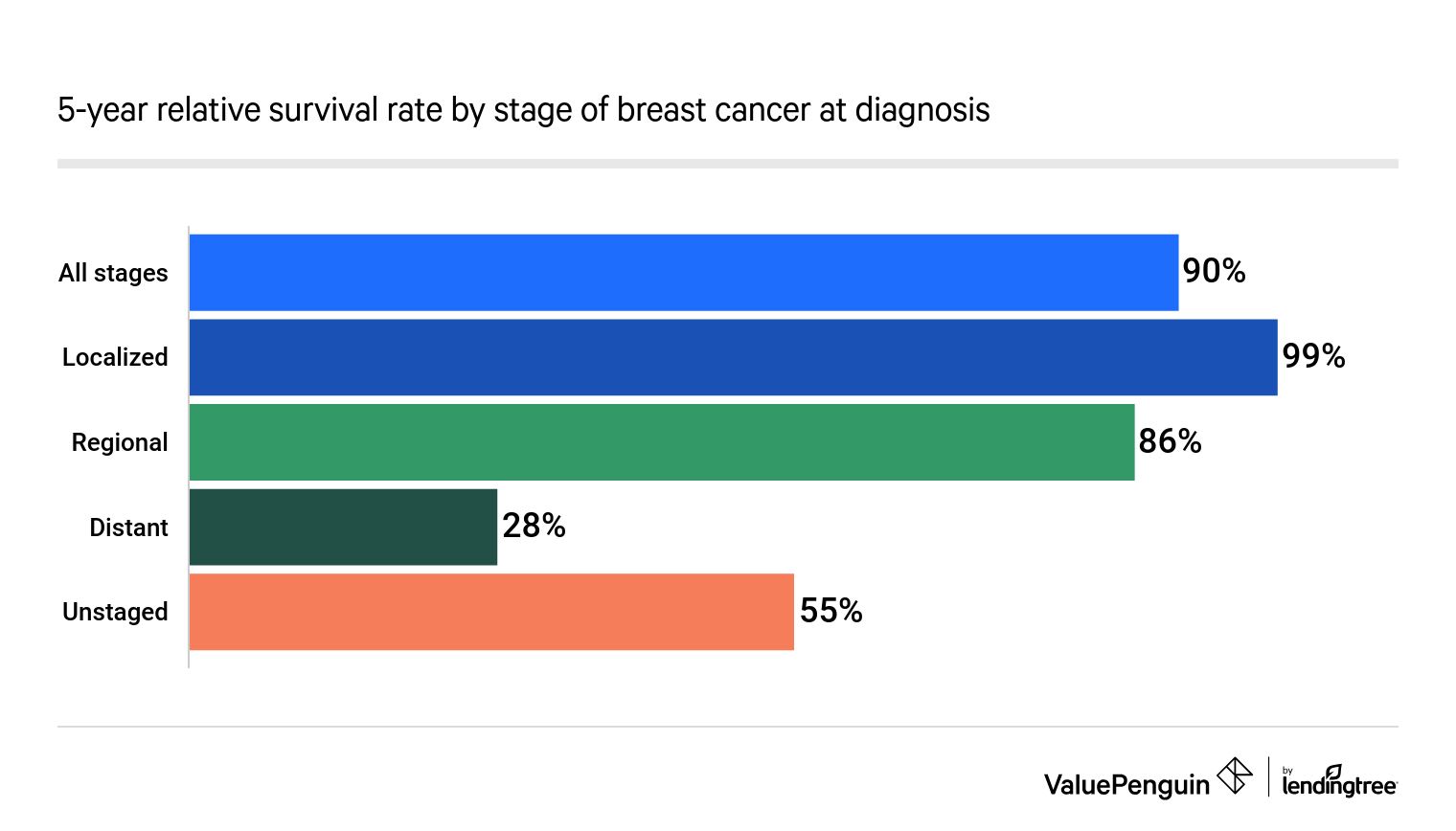Health Insurance
Stage 4 Breast Cancer Treatment & Chemo Costs Top $130,000

With a large portion of people being affected by the deadly disease, it’s crucial to recognize, identify and pursue ways to improve different types of treatment for women with breast cancer.
Key findings
- Female breast cancer has the highest rate of new cancer cases in the U.S. at 125.1 per 100,000.
- The District of Columbia has the highest breast cancer case rate in the nation at 145.9 per 100,000.
- Stage 4 cancer treatments cost $134,682 on average. However, surgery is more expensive for stage 0 breast cancer ($16,909), compared with stage 4 ($7,660).
- Five-year survival rates have been on the rise, reaching nearly 99% for patients with localized breast cancer.
The rate of new female breast cancer cases is more than 2.5 times that of new lung and bronchus cases
According to the Centers for Disease Control and Prevention (CDC), breast cancer has the second-highest cancer death rate among women at 19.9 per 100,000. Furthermore, breast cancer is the most common cancer for women.
When breaking down case rates by state, the District of Columbia (145.9 cases per 100,000 women) and Hawaii (144.3 per 100,000) have the highest rates of breast cancer in the nation. In general, four of the 10 highest rates of breast cancer are reported in the Northeast, including New Jersey (138.4), Rhode Island (137.3), Connecticut (136.9) and New Hampshire (136.3).
State-by-state rates of breast cancer
Average breast cancer treatment options can vary by 121% depending on the stage of cancer
The stage of breast cancer a person may have is crucial to making treatment decisions and determining financial costs. The latter stages of breast cancer will on average require a more aggressive treatment option — and cost significantly more. According to a study published via the National Center for Biotechnology Information (NCBI), a stage 4 breast cancer patient could expect to pay 64% more for treatment, surgery and hospital care compared with a stage 1 or 2 patient.
Stage of breast cancer | Average treatment cost |
|---|---|
| 0 | $60,637 |
| 1/2 | $82,121 |
| 3 | $129,387 |
| 4 | $134,682 |
A key factor in determining what costs patients could expect is the type of treatment recommended by the doctor. While the average cost of chemotherapy can be more than $34,000 for a stage 4 cancer patient, it can be significantly less ($5,000 on average) for earlier stage cancer.
Similarly, if your team of health professionals suggests surgery to remove the cancer instead of chemotherapy or radiation, the cost may depend on the stage of cancer. Stage 0 breast cancer patients could expect to pay 121% more for surgery compared to stage 4 patients.
Stage | Inpatient surgery | Outpatient surgery | Total |
|---|---|---|---|
| 0 | $4,291 | $12,618 | $16,909 |
| 1/2 | $4,722 | $11,783 | $16,505 |
| 3 | $6,573 | $12,637 | $19,210 |
| 4 | $3,180 | $4,480 | $7,660 |
Breast cancer stages refer to the cancer’s extent and are crucial to evaluating what type of treatment should be administered. If there’s been more spread, the cancer is classified as a later stage and requires more treatment.
For example, a stage 0 breast cancer diagnosis means that the cancer is limited to the milk duct and is noninvasive. On the other hand, stage 4 breast cancer, also known as metastatic breast cancer, means the cancer has spread to other parts of the body outside of the breasts.
Breast cancer survival rates are on the rise among all age groups, but there are still large differences among races
Since 2000, the death rate from female breast cancer has fallen by nearly seven deaths per 100,000 (19.7 in 2020 versus 26.6 in 2000). This represents a decrease in the per-100,000 death rate of nearly 26% over the past two decades.

When looking at survival rates of breast cancer by age, individuals between the ages of 65 and 74 have the highest rates of survival across all stages of cancer at diagnosis. Conversely, women ages 15 to 39 have the lowest five-year survival rates across all stages at around 85%.
However, this same age group has the highest rate of survival when analyzing a distant stage diagnosis at more than 39%. The National Cancer Institute defines a distant diagnosis as a tumor that has spread to areas of the body that are distant and remote from the primary tumor.
5-year relative survival rate (%) by age
Stage at diagnosis | Ages 15-39 | Ages 40-64 | Ages 65-74 | Ages 75+ |
|---|---|---|---|---|
| All stages | 86% | 91% | 92% | 86% |
| Localized | 95% | 98% | 100% | 100% |
| Regional | 84% | 88% | 87% | 74% |
| Distant | 39% | 30% | 27% | 19% |
| Unstaged | 74% | 70% | 58% | 30% |
Survival rates of breast cancer also fluctuate when broken down by race. Overall, Latino and Black Americans have the lowest rates of survival across all stages of diagnosis at 88% and 82%, respectively. Similarly, the survival rate with a distant stage diagnosis for a Black American is 19%, which is 10 percentage points lower than any other group.
On the other hand, the rate of surviving after a localized diagnosis exceeds 95% for all races, showing a strong trend in technology advancement to cure this type of breast cancer.
5-year relative survival rate (%) by race
Stage at diagnosis | Asian | Black | Latino | White |
|---|---|---|---|---|
| All stages | 92% | 82% | 88% | 91% |
| Localized | 99% | 96% | 97% | 99% |
| Regional | 87% | 77% | 84% | 87% |
| Distant | 33% | 19% | 31% | 29% |
| Unstaged | 58% | 50% | 59% | 53% |
Breast cancer treatment financial aid: Where to find it
As shown in this analysis, the costs of breast cancer treatment can pile up quickly. For this reason, some hospitals and treatment centers offer financial counselors to help you navigate paying for treatment.
If you’re diagnosed with cancer, it’ll be important to get a detailed understanding of your current health insurance policy. During treatment, doctors may recommend visiting a variety of specialists, such as radiologists. Make sure these individuals are covered in your plan's network.
Additionally, by evaluating your health insurance, you will gain an understanding of whether you have a policy that fits your needs. With increased medical costs expected, it may be valuable to purchase a plan with a lower deductible, allowing you quicker cost-sharing benefits with your health insurer.
Methodology
CDC data was used for historical state-by-state rates of breast cancer among women, as well rates of cancer by type. The National Center for Biotechnology Information provided breast cancer costs across stages. Survival rates by stage of diagnosis were compiled from the National Cancer Institute using the Surveillance, Epidemiology and End Results Program (SEER).